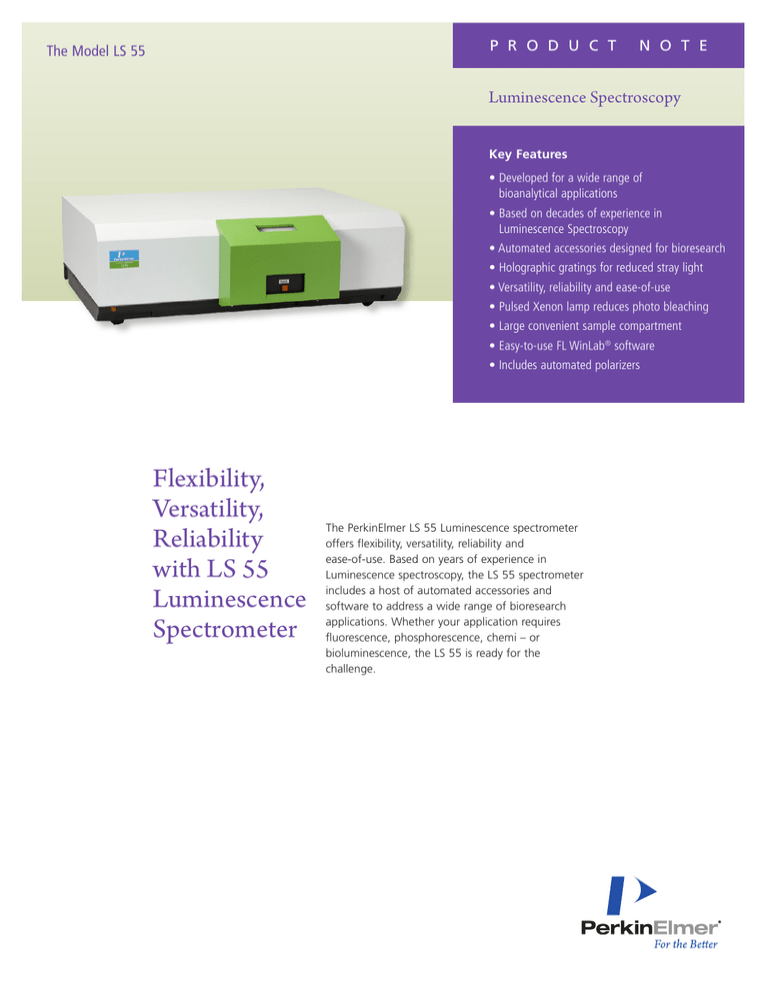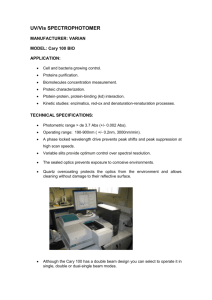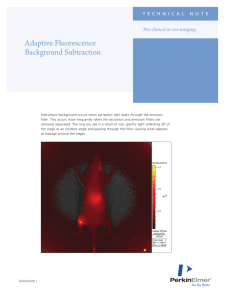
P R O D U C T
The Model LS 55
N O T E
Luminescence Spectroscopy
Key Features
• Developed for a wide range of
bioanalytical applications
• Based on decades of experience in
Luminescence Spectroscopy
• Automated accessories designed for bioresearch
• Holographic gratings for reduced stray light
• Versatility, reliability and ease-of-use
• Pulsed Xenon lamp reduces photo bleaching
• Large convenient sample compartment
• Easy-to-use FL WinLab® software
• Includes automated polarizers
Flexibility,
Versatility,
Reliability
with LS 55
Luminescence
Spectrometer
The PerkinElmer LS 55 Luminescence spectrometer
offers flexibility, versatility, reliability and
ease-of-use. Based on years of experience in
Luminescence spectroscopy, the LS 55 spectrometer
includes a host of automated accessories and
software to address a wide range of bioresearch
applications. Whether your application requires
fluorescence, phosphorescence, chemi – or
bioluminescence, the LS 55 is ready for the
challenge.
Bioresearch
Measurement modes for the LS 55
The LS 55 is built on PerkinElmer’s heritage of sensitivity and
reliability. A wide range of automated accessories have also
been developed for the system making it the system ideal for
bioresearchers conducting:
• F luorescence, phosphorescence and bio- and
chemi-luminescence-measurement modes
• Microplate-based measurements
•3
D excitation/emission scans, 3D synchronous and
kinetic scans
• Polarization
• Anisotropy assays
• Intact cell work
• Analysis of protein suspensions
Optical performance you can count on
Our monochromator based LS 55 uses a high energy
pulsed Xenon source for excitation. For more than 25 years
PerkinElmer has used pulsed Xenon sources to minimize
photobleaching of samples and provide a long-lived
excitation source.
The variable slit and holographic gratings provide flexibility
with very low stray radiation. We've incorporated holographic
gratings to further reduce stray light and improve the
system’s already impressive performance. And a newly
designed reference signal system has been added to provide
users with much more control over signal dynamics.
This is particularly useful for samples with widely differing
intra-sample signal size.
For example, the LS 55 signal system has reduced noise by a
factor of about 5 for intracellular ion analyses, and increased
data transfer rates by a factor of 10.
• E xcitation, emission, constant wavelength synchronous,
and constant energy synchronous spectral scanning
•M
icroplate measurements with fixed wavelength,
wavelength program or automated spectral data collection
• T LC plate, electrophoresis gel or other flat sample types can
be analyzed with our Plate Reader accessory
• Single and multiple wavelength kinetics
• Simultaneous kinetics for multiple samples
• S imple quantitation by curve fitting with a number of
fit algorithms
• Intracellular ion analyses
Accessories add sampling flexibility
The LS 55 includes a single cell thermostatted sample holder
that can accommodate 1 cm pathlength cells as well as
semi-micro cuvettes with or without stirring. Semi-micro
cuvettes are particularly useful where the sample is precious
or volume is limited such as cell cultures and DNA samples.
The system also includes an automated Polarizer that consists
of two filter wheels; each wheel containing a horizontal and
vertical polarizing element. Polarizer positions are software
controlled and can be manually set or automatically controlled
for polarization, anisotropy or G-factor. Additional accessories
are discussed below.
Powerful software controls your entire analyses
Our FL WinLab™ software is designed for demanding
laboratories. It seamlessly combines PerkinElmer's extensive
application specific knowledge and instrumentation control
with the ease-of-use provided by the Windows®
operating environment.
Specific modes of instrument operation such as Scan,
Time Drive, and Ratio Data Collection can be easily
accessed from the Applications Menu. Excitation and
emission monochromators can be independently or
synchronously scanned, while the Prescan mode is ideal
for method development and locating of peak excitation
and emission maxima.
FL WinLab includes a validation protocol that automatically
checks the instrument performance to ensure that it is
operating within specification. With its unique set of
accessories and software applications, the LS 55 offers
the most powerful and flexible system for data collection
and analysis.
2
Front Surface accessory
The Front Surface accessory is ideal for analyzing films,
papers, powders and other flat samples. The sample may be
placed in the accessory directly or held in the powder holder
that has a synthetic fused silica window. Ultrasmall volumes
or viscous samples such as oils, opaque and turbit samples
may be measured via the powder holder or cuvette.
LC flow cell
The LC flow cell for high sensitivity liquid chromatography
is a good means of expanding the utility of the LS 55.
Providing laboratories with an alternative to a dedicated
LC fluorescence detector. The twin monochromators of the
system enable accurate wavelength selection for maximum
selectivity and sensitivity.
Remote Fiber Optic accessory
Sipper accessory
The Remote Fiber Optic accessory allows you to take the
measurement at the sample rather than taking the sample to
the instrument. It is ideal for remote, non-destructive testing
of fluorescent papers and fabrics as well as the sampling of
hazardous materials such as radioactive sources.
A Sipper accessory is available for those laboratories that
would like to automate routine analysis and quantitation. It
automatically moves the sample from your sample vessel to the
measurement cuvette, and minimizes the need to handle and
clean quartz cuvettes.
S10 Autosampler accessory
Biokinetics accessory
The high throughput S10 Auto sampler, when coupled to the
LS 55, can measure up to 200 samples in a single rack. This
provides a high sensitivity alternative to microplate reading. The
autosampler has a built in peristaltic pump that is controlled
directly by a dedicated software program for collection of
intensity, polarization or anisotropy measurements.
The Biokinetics accessory consists of a single position stirred
cell holder with event marking and temperature sensing. It is
useful for all life science based work, but particularly useful for
polarization anisotropy work, protein folding/unfolding, and
DNA melting.
Fast Filter accessory
Unleash the LS 55 for bioresearch
Plate Reader accessory
The Plate Reader accessory is a sensitive and easy-to-use way
to measure fluorescence based assays in multiwell plates.
Controlled from the LS 55, it is able to use a wide range of
UV and Visible wavelengths ensuring the detection of virtually
all fluorescent dyes used in for bio assays. Two programs are
included in FL WinLab for the Plate Reader. One allows the user
to create flexible wavelength programs for single end-point
and kinetic analyses: The other allows the measurement of
flat samples such as gels, and presents data as a 3D image. In
addition, an optional plug-in program allows the user to collect
up to 100 spectra per well.
Autopole system and software
The Autopole system and software automates the
measurement of polarization or anisotropy versus temperature
It includes a temperature control system with temperature
sensing built into the cuvette.
The Fast Filter accessory is used for rapidly collecting data
when studying biochemical processes such as intracellular
ion monitoring. Pairs of optical filters specifically designed for
the indicator dyes are rotated rapidly in either the excitation
or emission beam allowing ratio measurements to be made
every 40 millisecond. Two pairs of filters can be fitted on
each wheel. The ratio data or the individual intensities can be
viewed in real-time. For example, the Fast Filter allows for the
simultaneous measurement of both calcium and pH using a
pair of FURA-2 and BCECF filters.
4-position automatic Cell Changer
The 4-position automatic Cell Changer includes water
thermostatting and stirring for each sample position. This is
especially useful for simultaneous, multiple time-dependent
measurements from each of 4 cuvettes. Multiple samples can
now be multiplexed for analyses such as enzyme activities.
Applications
Applications for fluorescence can be found in many laboratories in a range of industries such as:
Cell based
Cytotoxicity, cell viability, cell quantification, cell proliferation, adhesion, reporter gene expression, apoptosis
Clinical
Enzyme and substrate assays, porphyrins, steroids, blood flow
Environmental
Pesticide detection on many substrates including leaves, ground water tracing, oil contamination of fresh and marine water,
EROD assays, chlorophyll determination of normal and toxic algae
Pharmaceutical
Vitamins, biogenic amines, pharmaceutical and abuse drugs, toxicity assays, cell function assays
Inorganic
Aluminum, lead, magnesium, manganese, selenium, tin, zinc
Molecular biology
DNA quantification, gene expression, membrane structure and function, protein folding/unfolding, protein quantitation, enzyme
activity, PCR product quantitation
Industrial
Crack tracing in the aerospace industry, security inks, coding phosphors, brightening/whitening agents, UV stabilizers and
plasticizers, LED and TFT screen, solid state physics R&D
3
4
Specifications LS 55
PrincipleComputer controlled ratioing luminescence spectrometer with the capability of measuring fluorescence, phosphorescence or
chemiluminescence, and bioluminescence.
Pulse rate, delay and gate times can be varied.
Source
Xenon flash lamp, pulsed at line frequency (50 or 60 Hz). Pulse width at half peak height < 10μs, power equivalent to
20 kW at continuous operation. Delay (td) and gate time (tg) can be varied to measure phosphorescence.
Source can be turned off for measuring chemiluminescence and bioluminescence.
Optics
Monk-Gillieson type monochromators using low stray light, holographic gratings cover the following ranges:
Excitation 200-800 nm with zero order selectable
Emission 200-650 nm with zero order selectable (standard photomultiplier)
200-900 nm with zero order R928 photomultiplier (optional)
Synchronous scanning is available with constant wavelength or constant frequency difference. Excitation spectra are
automatically corrected.
An excitation filter wheel is incorporated into the optical unit and inserts a 390 nm cut-off filter as an excitation spectrum
is scanned through 410 nm.
Excitation and Emission Polarizers consisting of 2 filter wheels, each with horizontal and vertical polarizer elements are included.
+ 1 nm
Wavelength accuracy
Wavelength
reproducibility
Spectral bandpass
The excitation slits 2.5-15 nm and emission slits 2.5-20 nm can be varied and selected in 0.1 nm increments.
Scanning speed
The scanning speed can be selected in increments of 1 nm from 10–1500 nm/minute.
Data can also be collected with respect to time.
Emission filters
Sensitivity
Computer selectable cut-off filters, 290, 350, 390, 430 and 515 nm, a blank (to act as a shutter), a 1 % attenuator, and a clear beam position.
Minimum signal-to-noise level using the Raman band of water, excitation 350 nm, is 750:1 RMS measuring noise on the
Raman peak, and 2500:1
RMS measuring noise on the baseline.
A single position water thermostatted holder for 10 mm cuvettes.
Standard sample holder
+ 0.5 nm
Accessories
Front Surface accessory
LC Flow Cell accessory
Remote Fiber Optic accessory
S10 Autosampler
Computer controlled
accessories
Single position water thermostatted stirred cell holder.
Four position water thermostatted automatic cell changer.
Excitation and emission polarizers with 40 msec signal sampling.
Sipper accessory.
Well plate reader accessory available with standard or far-UV fiber optics.
Total emission accessory.
Biokinetic accessory.
Fast filter accessory.
Data acquisition
Instrumental parameters are controlled by FL WinLab software, which is installed in the Windows environment.
The luminescence intensity and the excitation and emission wavelengths can be displayed in real-time. Spectral and time drive data are displayed in real-time and can be stored on disc.
Data analysis
Routines are available for performing mathematical calculations on stored data. These include arithmetic functions,
smoothing, 1-4th order derivatives, area, peak, normalization, merge, difference, interpolate.
Specific applications programs are provided for determining intracellular ion concentration and simple quantitation.
Presentation quality output is available using the Report Builder program.
Data output
Data system
processor Intel® Pentium 4 or equivalent, 1.6 GHz processor, or equivalent
At least 1 GB of Random Access Memory (RAM)
The capability of displaying at least high color (16 bit) at 1280 x 768
40 GB Hard disk with at least 1 GB free space as an NTFS drive
CD-ROM drive, 1 RS232 port, 1 USB port
Operating System: Windows® 7, 32 bit operating system required
Note: FL WinLab will operate under Windows® 7, 32 bit.
Power requirements
90 – 132 VAC, 50/60 Hz, 2A
200 – 264 VAC, 50/60 Hz, 1A
Dimensions
265 mm high, 790 mm wide, 680 mm deep (including sample compartment).
Weight 49.5 kg.
For more information, please visit our website at www.perkinelmer.com
PerkinElmer, Inc.
940 Winter Street
Waltham, MA 02451 USA
P: (800) 762-4000 or
(+1) 203-925-4602
www.perkinelmer.com
For a complete listing of our global offices, visit www.perkinelmer.com/ContactUs
Copyright ©2013, PerkinElmer, Inc. All rights reserved. PerkinElmer® is a registered trademark of PerkinElmer, Inc. All other trademarks are the property of their respective owners.
006410E_01



